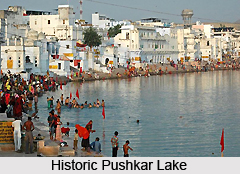 The name Pushkar means that the place originated because of a flower. According to Hindu mythology the gods released a swan that carried a lotus in its beak and let it fall on earth. In this way they decided the venue where Lord Brahma would perform his yagna. In Hindu religion Lord Brahma is looked upon as the creator of the universe. The place where the lotus fell from the beak of the swan was named Pushkar. The history of Ajmer is steeped in mythology and religion. Even today it is one of the 5 holy sites of pilgrimage for the Hindus. It is often called the "Tirth Raj."
The name Pushkar means that the place originated because of a flower. According to Hindu mythology the gods released a swan that carried a lotus in its beak and let it fall on earth. In this way they decided the venue where Lord Brahma would perform his yagna. In Hindu religion Lord Brahma is looked upon as the creator of the universe. The place where the lotus fell from the beak of the swan was named Pushkar. The history of Ajmer is steeped in mythology and religion. Even today it is one of the 5 holy sites of pilgrimage for the Hindus. It is often called the "Tirth Raj."
Apart from the legend associated with Lord Brahma the city of Pushkar is also mentioned in the Hindu epics Ramayana and Mahabharata. The former says that the great sage Vishvamitra performed a yagna here. On the other hand Yudhishthara, the eldest Pandava brother visited the region to take a bathe in the Pushkar Lake. In Puranas too Pushkar is depicted as a place for pilgrimage that is visited by Prahlada. Pushkar was restored to its earlier beauty in the 7th century by Nahadarava, the Pratihara ruler of Mandore.
To beautify the city of Pushkar the king cleaned the lake and the places surrounding it. The ancient palaces were renovated and even rebuilt. For the convenience of the travelers and pilgrims 12 dharmasalas or inns were built. The lake was embanked and three ghats were built around it.
Besides these Pushkar is seen as the birthplace of several important sages. Parasara is one of them. Till date his descendants are found in Pushkar and they are called the Parasara Brahmans.
The history of Pushkar remains unscathed by the turbulent times that the rest of the Rajputana went through. Located merely at a distance of 11 kilometers even Ajmer went through trying times. But as the travelers visit the place they will realize that Pushkar remained unaffected by such problems.



















